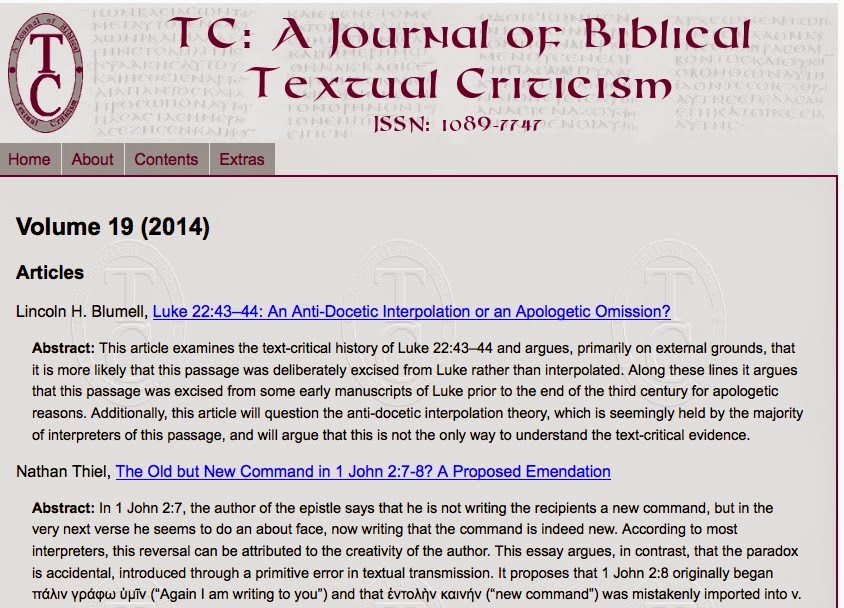The 19th volume of TC: A Journal of Biblical Textual Criticism (2014) is now complete. A number of new articles have just been published on-line. The volume contains three full-length articles, two shorter articles ("notes"), one review article and plenty of book reviews.
The editors welcome new submissions to the journal (see instructions here).
Here is the contents with links and abstracts:
Volume 19 (2014)
Articles
- Lincoln H. Blumell, Luke 22:43–44: An Anti-Docetic Interpolation or an Apologetic Omission?
- Abstract: This article examines the text-critical history of Luke 22:43–44 and argues, primarily on external grounds, that it is more likely that this passage was deliberately excised from Luke rather than interpolated. Along these lines it argues that this passage was excised from some early manuscripts of Luke prior to the end of the third century for apologetic reasons. Additionally, this article will question the anti-docetic interpolation theory, which is seemingly held by the majority of interpreters of this passage, and will argue that this is not the only way to understand the text-critical evidence.
- Nathan Thiel, The Old but New Command in 1 John 2:7-8? A Proposed Emendation
- Abstract: In 1 John 2:7, the author of the epistle says that he is not writing the recipients a new command, but in the very next verse he seems to do an about face, now writing that the command is indeed new. According to most interpreters, this reversal can be attributed to the creativity of the author. This essay argues, in contrast, that the paradox is accidental, introduced through a primitive error in textual transmission. It proposes that 1 John 2:8 originally began πάλιν γράφω ὑμῖν (“Again I am writing to you”) and that ἐντολὴν καινήν (“new command”) was mistakenly imported into v. 8 early on in the letter’s textual history. By emending the text, we are able to resolve the grammatical and contextual anomalies of the present reading.
- Gareth Wearne, קרנים מידו לוand :מימינו אשדת למו Reading Habakkuk 3:4 and Deuteronomy 33:2 in Light of One Another
- Abstract: Habakkuk 3:4 and Deuteronomy 33:2 have long resisted straightforward interpretation. However, both verses apparently belong to the same tradition of southern theophany and both share a similar syntax and imagery. This short paper argues that both verses can be used to shed light on each other, and that the unusual syntax of the MT preserves an ancient idiomatic expression.
Notes
- Hans Förster, Μαρία and Μαριάμ in John’s Gospel in the Novum Testamentum Graece
- Abstract: The name Mary was popular and a number of different women with this name are mentioned in the Gospel of John. The text of the Gospel of John in the Novum Testamentum Graece uses in this context the Hellenized and the transcribed form of the name “Mary” rather unsystematically. A scrutiny of the evidence as presented in the manuscripts points to a problem: cases where the transliterated form is used as accusative might be not so much a decision to use a transliterated form but a misspelled form of the Greek accusative—exchange of the nasals is a known phenomenon. That is, the distribution of forms of the name might in part be due to phonetics and incorrect spellings and not to a decision to use one of the two forms of the name. A possible conclusion might be that the Greek text of the Gospel of John should present only the Hellenized form and relegate the transcribed form to the apparatus (which in quite a few instances would accord with the fact that the Hellenized form may be better attested than the transcribed form).
- Dirk Jongkind, 059 (0215) and Mark 15:28
- Abstract: What remains of this parchment codex suggests that it lacked Mark 15:28.
Review Articles
- Georg Gäbel, A Fresh Look at the Early Text
- Abstract: A review article on The Early Text of the New Testament (Charles E. Hill and Michael J. Kruger, eds).
Reviews
- Ariel Feldman, The Rewritten Joshua Scrolls from Qumran: Texts, Translations, and Commentary (Marcus Sigismund, reviewer)
- Kim Haines-Eitzen, The Gendered Palimpsest: Women, Writing, and Representation in Early Christianity (Thomas J. Kraus, reviewer)
- Margaret Jaques (ed.), Klagetraditionen: Form und Funktion der Klage in den Kulturen der Antike (Matthias Millard, reviewer)
- Timothy M. Law, Origenes Orientalis: The Preservation of Origen’s Hexapla in the Syrohexapla of 3 Kingdoms (Martin Meiser, reviewer)
- Kathleen Maxwell, Between Constantinople and Rome: An Illuminated Byzantine Gospel Book (Paris gr. 54) and the Union of Churches (J. K. Elliott, reviewer)
- Reinhard Müller, Juha Pakkala, and Bas ter Haar Romeny, Evidence of Editing: Growth and Change of Texts in the Hebrew Bible (Andrew W. Dyck, reviewer)
- A. Piquer Otero and P. A. Torijano Morales (eds.), Textual Criticism and the Dead Sea Scrolls: Studies in Honour of Julio Trebolle Barrera (Bennie H. Reynolds III, reviewer)
- Richard Simon, Critical History of the Text of the New Testament: Wherein is Established the Truth of the Acts on which the Christian Religion is Based (Translated, Introduced and Annotated by Andrew Hunwick) (Jan Krans, reviewer)
- Alison S. Welsby, A Textual Study of Family 1 in the Gospel of John (Thomas J. Kraus, reviewer)
- Ryan D. Wettlaufer, No Longer Written: The Use of Conjectural Emendation in the Restoration of the Text of the New Testament: The Epistle of James as a Case Study (Jan Krans, reviewer)
- Andrew T. Wilburn, Materia Magica: The Archaeology of Magic in Roman Egypt, Cyprus, and Spain: New Texts from Ancient Cultures (Thomas J. Kraus, reviewer)

Thanks Tommy for the links (and thanks Jan too).
ReplyDelete